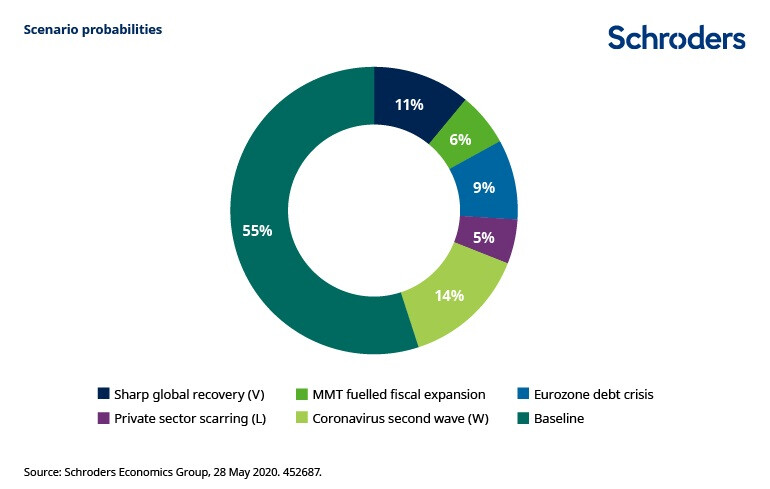Why we think the recovery will be U-shaped
We've gone from predicting a V-shaped recovery to a U-shape, given the difficulties of lifting lockdown.

Authors
We are downgrading our forecast for global growth once more to reflect the weakness seen in the first quarter. Overall we see global activity falling 5.4% this year, a downgrade from our previous forecast of -2.9% and mainly driven by downgrades to the US and China. We expect the recovery to be gradual as households and firms remain cautious.
In 2021, global growth should improve to 5.3%, based on fiscal and monetary policy remaining loose and, on the medical front, a vaccine being successfully developed by mid year.
We have also downgraded our global inflation forecast to 1.5% in 2020 (from 1.9% previously) and 1.8% in 2021 (previously 2.1%).
Are we past the worst yet?
On a global basis, activity in the second quarter is likely to be as bad if not more severe than in the first quarter, as the lockdowns extended through April and into May. However, some of the data suggests we are past the worst: for example, industrial metals prices have stabilised and Google mobility data suggests that activity in the workplace is picking up, albeit from a low level.

From here we should see activity improve as lockdowns eased toward the end of May and have been loosened further in June. As a result, Q3 should see something of a bounce in activity, albeit to a lesser extent than we had previously anticipated; we think the economy will fail to regain all the ground lost in the first half of the year.
Why is the rebound expected to be weaker compared to the last forecast?
We expect the rebound to be weaker compared to our previous forecast because of four broad factors:
- Difficulties in lifting lockdowns: Specifically, the trade-off governments face between putting economies back to work and the health risks of exposing people to Covid-19. Many scientists warn of the danger of a second wave of infection.
- Cautious consumers: The experience of the virus will make people more cautious in general. In some areas, spending habits will not return for some time such as in the travel, hospitality and leisure sectors.
- Rollback in government support: Less support for business means further household uncertainty over future employment, adding to consumer reticence to spend.
- Business investment to suffer: At the corporate level, the uncertainty over the outlook will weigh on investment, and following the sharp increase in debt, we would expect a period of de-leveraging from firms as we go through 2021. This will weigh on real activity and incomes as firms prioritise debt reduction over spending on new equipment and technology or dividends.
All of this means we’ll not regain pre-Covid levels of activity by the end of 2021, making the forecast less of a V shape and more of a U.
How does the picture differ across regions?
US: Growth forecast cut to -8.2% for 2020 from -3.9% following a weaker-than-expected Q1 and a downgrade to our projection for the second half of the year.
Eurozone: Eurozone growth has been revised down to -6.1% from -5.7% for 2020 with the main change driven by the new information received from Q1 GDP data.
UK: GDP growth has been downgraded from -7.2% to -8.5% for 2020 for the same reason.
Japan: We expect the economy to contract by 5.4% in 2020 (faring better than most of its developed market counterparts) reflecting a lower scale of shutdown and strong government support.
Emerging markets: The biggest change to our emerging markets forecast is our outlook for China; we revise our Chinese growth forecast sharply lower for 2020 to 2.2% from 5%.
The rest of the BRIC economies (Brazil, Russia, India, China) also receive downgrades with the group no longer expected to experience growth of 1.8%, but a contraction of -2.2%. This is partly because they have had to impose longer lasting lockdowns than we had previously anticipated and in part because globally we are now assuming a more protracted recovery, which has consequences for trade.
What other scenarios could we face?
We think the most likely risk to our central view is that we see a W-shaped recovery. This will result from the virus returning later in the year and lockdowns being re-imposed, creating a double-dip recession.
The V-shape recovery is the next most likely scenario. In this scenario, the virus remains subdued and the private sector responds more positively to the lifting of lockdowns, and government and central bank support.
That another eurozone debt crisis transpires is our third greatest risk. These scenarios all point to lower inflation than in the base case.
Lower probability scenarios include the L-shaped recovery (in which a much more severe increase in private sector caution keeps activity weak for longer) and an MMT (modern monetary theory)-fuelled fiscal expansion (in which governments print money and disburse it directly to the public to support economic growth).

The forecasts included should not be relied upon, are not guaranteed and are provided only as at the date of issue. Our forecasts are based on our own assumptions which may change. We accept no responsibility for any errors of fact or opinion and assume no obligation to provide you with any changes to our assumptions or forecasts. Forecasts and assumptions may be affected by external economic or other factors.
Authors
Topics